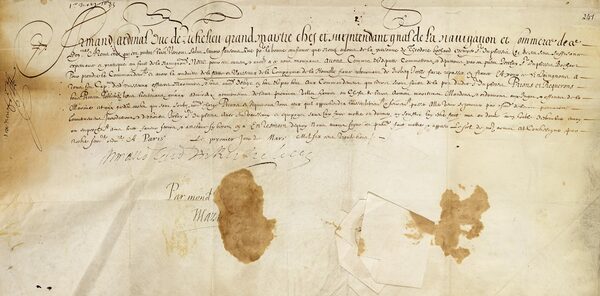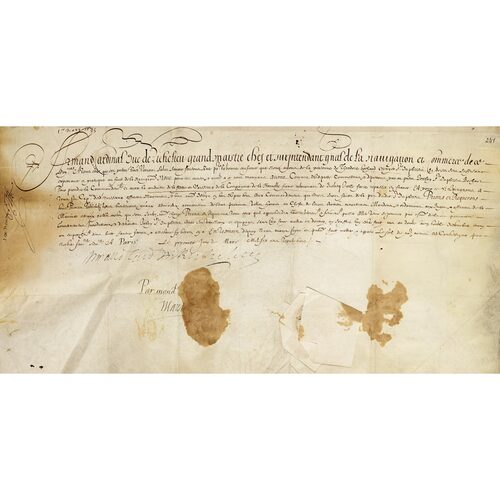
Source: Link
BOCHART (Bochard), THÉODORE (also known as Bochart du Plessis, Du Plessis-Bochard, Du Plessis-Bochart, and Plessis-Bochart), esquire, Sieur du Plessis, lieutenant of Émery de Caën, general of the fleet of the Compagnie de la Nouvelle-France, Sieur of Ménillet, ship’s captain, and Seigneur de Cornou; b. 17 April 1607 in Paris, son of Christophe (Matthieu) Bochart, a lawyer in the judicial court (Parlement) of Paris, and Jeanne de Forges; d. 2 June 1653 in Bordeaux, France.
Origins
The Bocharts were a noble French family from Burgundy; the branch from Ménillet embraced Protestantism. Orphaned at about nine years of age, Théodore Bochart grew up under the guardianship of his aunt Marie Bochart and his uncle Pierre Berger, adviser to King Louis XIII at the judicial court (Parlement) of Paris. It was probably through his uncle that Bochart entered the service of Armand-Jean du Plessis, Cardinal de Richelieu, before 1631.
Retaking Quebec’s fort
The treaty of Saint-Germain-en-Laye, which restored Canada to France on 29 March 1632, marked Bochart’s debut as Commandant Émery de Caën’s lieutenant. The two men were to regain possession of Quebec’s fort, which had been in the hands of the Kirke brothers since 1629, and to take over the monopoly of the fur trade along the St Lawrence. They left France for New France on 18 April 1632 and on 13 July the Kirkes surrendered the fort. Bochart spent the winter at Quebec. The lieutenant regularly pursued English, Dutch, and French smugglers who were diverting trade for their personal profit.
When Samuel de Champlain, the settlement commander, returned to Quebec on 23 May 1633, de Caën first handed over the fort to Bochart, who took possession in the name of the king and of Cardinal de Richelieu and the Compagnie de la Nouvelle-France. On 24 May Champlain assumed authority and gave Bochart a commission signed by the cardinal, which conferred on him command of the fleet and vessels of the Compagnie de la Nouvelle-France that were returning to France.
Trois-Rivières
On 24 May the Montagnais (Innu) chief Capitanal suggested to Champlain that his people share a new, permanent habitation with the French at Trois-Rivières. The deal was settled, and it was agreed they would trade furs there the following year. Bochart set sail for France on 16 Aug. 1633, arriving on 1 October.
He was back at Quebec by early June 1634, having brought, on one of his ships, the apothecary and master surgeon Robert Giffard de Moncel and a group of immigrants who were to be among the first settlers in New France. On 5 July Bochart reached Trois-Rivières to trade furs as had been agreed with France’s allies, the Montagnais, Huron (Huron-Wendat), and Algonkin. A man named Laviolette, who had arrived a day earlier, transported in his bark the materials, provisions, and artisans needed to build a permanent habitation. In August, at Quebec, Bochart informed Paul Le Jeune, superior of the Jesuits there, of the progress being made on the new dwelling at Trois-Rivières, which was rather too primitive to withstand the coming winter. Bochart sailed for France on about the 18th. Famine, disease, cold, and overcrowding decimated the first inhabitants who wintered at Trois-Rivières.
Trade and relations with the First Nations
Bochart returned to New France during the first half of July 1635. Along with Champlain, he held discussions with the Huron at Quebec to persuade them to bring Jesuits to their territory. It is likely that Bochart then travelled to Trois-Rivières over the next few days; little is known about his time there. It seems that he engaged in and mastered fur-trading protocols. He would have welcomed and met with Indigenous suppliers, held talks with them, negotiated exchanges, and observed appropriate rituals upon their departure – offering gifts, providing feasts, and ordering that cannons be fired. Most importantly, Bochart, who in the Jesuit Relations is sometimes described as the “general of the fleet,” transported the valuable cargo to France at the end of the summer. The following winter was spent preparing ships for the return to New France in the spring.
Champlain died on 25 Dec. 1635. In June of the following year, Bochart arrived with Charles Huault de Montmagny, the first governor and lieutenant-general of New France. The Montagnais chief Etouet was eager to meet him as well as Bochart, whom he regarded as his brother. The mutual trust essential to maintain the supply of furs was consolidated: Bochart had not only the necessary authority to smooth over discord among Indigenous peoples and to ask that they entrust their children to the Jesuits, but also the well-deserved recognition of France’s Indigenous allies. To compensate for the 1633 murder of three Frenchmen by the Agniers (Mohawk), the Montagnais chief Makheabichtichiou offered him a young Iroquois (Haudenosaunee) girl, Anne-Thérèse, to be instructed by the Carmelites. Sometime after 22 August, Bochart made his final departure from Trois-Rivières, his ship’s cannons firing. Seven days later, at the head of a fleet loaded with furs, he weighed anchor at Quebec. Bochart’s activities in New France during the 1630s offer useful supplemental information about the circumstances of the founding of Trois-Rivières, long vaguely attributed to Laviolette alone.
Last years in France
Théodore Bochart returned to France in 1636, and sources indicate that at some point he transferred from the merchant navy to the royal navy. As a captain he would have matured along with the great mariners of his time, such as the Duc de Brézé, nephew of Cardinal de Richelieu, and the Duc de Vendôme, as well as others who were associated with New France, including Guillaume de Caën and Claude de Launay-Rasilly, brother of Isaac de Razilly. He would distinguish himself in combat, particularly against the Spanish at Cadiz, Spain, in 1640 and off Italy’s coast at Castellammare in 1647. Yet he met with humiliation in 1652 when the English apparently captured his fleet; it was probably attempting to transport supplies to Dunkirk, which had been besieged by the Spanish. On 11 Jan. 1640 at Nargis, France, he had signed a marriage contract with Louise de Thiballier. The couple had at least four children: Théodore, Louise, and two girls both named Marie. Bochart died on 2 June 1653, apparently while serving during the siege of Bordeaux. The following day he was interred in Saint-Sauveur church in Blaye.
Some authors who have written about Théodore Bochart have wrongly referred to him as Charles. The first name Théodore appears clearly on the commission given to Bochart by Samuel de Champlain in 1633 (Bibliothèque Nationale de France, Dép. des mss (Paris), Français 26860, f.241).
Arch. Départementales, Gironde (Bordeaux, France), “Registres paroissiaux et d’état civil (1538–1935),” Blaye-et-Sainte-Luce (Gironde) [now: Blaye (Gironde)], 2 juin 1653 : archives.gironde.fr/archive/recherche/etatcivil/n:629 (consulted 15 May 2024). Arch. Nationales (Centre d’arch. de Paris), Y//182, f.405. Bibliothèque et Arch. Nationales du Québec, Centre d’arch. de la Mauricie et du Centre-du-Québec (Trois-Rivières, Québec), CE401-S48, 1634–79. Centre d’Études Acadiennes Anselme-Chiasson, Univ. de Moncton (N.-B.), 20.5-10. FamilySearch, “France, Protestant church records, 1536–1897”: www.familysearch.org (consulted 29 May 2024). [Gustave] C[haix] d’E[st]-A[nge], Dictionnaire des familles françaises anciennes ou notables à la fin du xixe siècle (20 tomes, Évreux, France, 1903–29), 5. Henri d’Escoubleau de Sourdis, Correspondance de Henri d’Escoubleau de Sourdis … (3 tomes, Paris, 1839), 1. Gaston Ducaunnès-Duval et J.-A. Brutails, Inventaire sommaire des archives départementales antérieures à 1790, Gironde: série E supplément (4 tomes, Bordeaux, 1898–1909), 2. Michel Fauvin, Nargis: lumières sur son passé (Châtillon-Coligny, France, 2017). Yannick Gendron, L’énigme de Trois-Rivières: Théodore Bochart (1607–1653), personnage clé de notre histoire (Shawinigan, Québec, 2019). Eugène et Émile Haag, La France protestante (2e éd., 3 tomes, Paris, 1873–82); La France protestante, ou vies des protestants français qui se sont fait un nom dans l’histoire … (10v., Paris, 1846–59), 2. A[uguste] Jal, Abraham Du Quesne et la marine de son temps (2 tomes, Paris, 1873), 1. [Charles de La Roncière], Histoire de la marine française (5v., Paris, 1909–20), 5. Paul Le Jeune, Relation de ce qui s’est passé en la Nouvelle France, en l’année 1634 (Paris, 1635); Relation de ce qui s’est passé en la Nouvelle France en l’année 1635 (Paris, 1636); Relation de ce qui s’est passé en la Nouvelle France en l’année 1636 (Paris, 1637). Benjamin Sulte, “Bochart et Kerbodot,” BRH, II (1896): 178–82. Marcel Trudel, Histoire de la Nouvelle-France (6 tomes in 7v., Montréal, 1955–99), 3 (La Seigneurie des Cent-Associés, 1627–1663), tome 1 (Les événements).
Cite This Article
Yannick Gendron, “BOCHART (Bochard), THÉODORE (Bochart du Plessis, Du Plessis-Bochard, Du Plessis-Bochart, Plessis-Bochart),” in Dictionary of Canadian Biography, vol. 1, University of Toronto/Université Laval, 2003–, accessed January 19, 2026, https://www.biographi.ca/en/bio/du_plessis_bochart_charles_1E.html.
The citation above shows the format for footnotes and endnotes according to the Chicago manual of style (16th edition). Information to be used in other citation formats:
| Permalink: | https://www.biographi.ca/en/bio/du_plessis_bochart_charles_1E.html |
| Author of Article: | Yannick Gendron |
| Title of Article: | BOCHART (Bochard), THÉODORE (Bochart du Plessis, Du Plessis-Bochard, Du Plessis-Bochart, Plessis-Bochart) |
| Publication Name: | Dictionary of Canadian Biography, vol. 1 |
| Publisher: | University of Toronto/Université Laval |
| Year of publication: | 1966 |
| Year of revision: | 2025 |
| Access Date: | January 19, 2026 |



